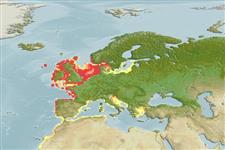Malacostraca |
Decapoda |
Portunidae
Environment: milieu / climate zone / εύρος βάθους / distribution range
Οικολογία
; εύρος βάθους 0 - 80 m (Αναφ. 356), usually ? - 40 m (Αναφ. 435). Temperate; 4°C - 28°C (Αναφ. 112013), preferred 9°C (Αναφ. 107945); 61°N - 24°N, 16°W - 28°E
Atlantic and the Mediterranean Sea: From western Norway to the UK to Western Sahara and the Mediterranean coasts of Spain, France and Italy. Subtropical to temperate.
Length at first maturity / Μέγεθος / Weight / Age
Γεννητική Ωρίμανση: Lm 4.8, range 4 - 5.95 cm Max length : 10.9 cm CL αρσενικό/απροσδιόριστο; (Αναφ. 96051); 9.84 cm CL (female); common length : 4.5 cm CL αρσενικό/απροσδιόριστο; (Αναφ. 435); μεγ. αναφερόμενη ηλικία: 8 έτη (Αναφ. 96051)
Maximum depth range from Ref. 101396. Maximum carapace width: 8.4; common carapace width: 5.5 cm (Ref. 435). Common in shallow waters from the intertidal to 80 m (Ref. 83653), common at depths not deeper than 40 m (Ref. 435). Found mostly in rocky shores, confined to the lower tidal mark (Refs. 101396). Inhabits on sand or mud (Ref. 435). Carnivore; trophic level 2.6 (Ref. 96418), trophic level 2.98 (Ref. 435). An opportunistic feeder, mostly preys on molluscs and crustaceans and also feeds on detrital material and large quantities of brown algae (Ref. 96482).
Members of the order Decapoda are mostly gonochoric. Mating behavior: Precopulatory courtship ritual is common (through olfactory and tactile cues); usually indirect sperm transfer.
SAUP Database 2006 SAUP Database. www.seaaroundus.org. (Αναφ. 356)
IUCN Red List Status
(Αναφ. 130435: Version 2025-1)
CITES status (Αναφ. 108899)
Not Evaluated
Not Evaluated
Threat to humans
Human uses
αλιεία: Εμπορικό(ά)
FAO - αλιεία: landings | FishSource | Η θάλασσα γύρω μας
Εργαλεία
Περισσότερες πληροφορίες
PhysiologyΚατανάλωση οξυγόνου
Human RelatedStamps, coins, misc.
Διαδικτυακές πηγές
Estimates based on models
Fishing Vulnerability
Low to moderate vulnerability (33 of 100).
Climate Vulnerability
High vulnerability (56 of 100).
Nutrients : Calcium = 109 [35, 184] mg/100g; Iron = 1.59 [1.21, 1.97] mg/100g; Protein = 20.2 [19.2, 21.3] %; Omega3 = 0.285 [0.185, 0.386] g/100g; Selenium = 48.3 [-31.7, 128.3] μg/100g; VitaminA = 0 μg/100g; Zinc = 1.79 [1.17, 2.40] mg/100g (wet weight); based on
nutrient studies.
